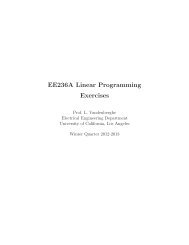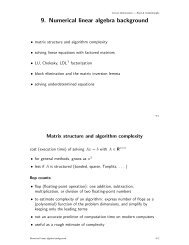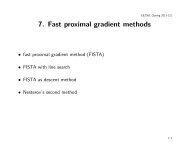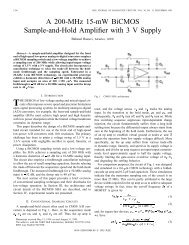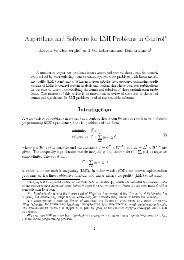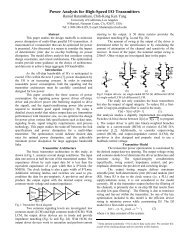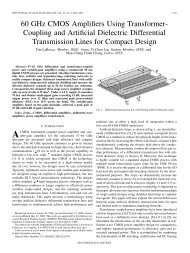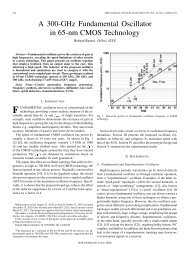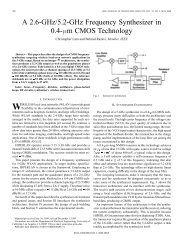A study of phase noise in CMOS oscillators - UCLA Electrical ...
A study of phase noise in CMOS oscillators - UCLA Electrical ...
A study of phase noise in CMOS oscillators - UCLA Electrical ...
You also want an ePaper? Increase the reach of your titles
YUMPU automatically turns print PDFs into web optimized ePapers that Google loves.
IEEE JOURNAL OF SOLID-STATE CIRCUITS, VOL. 31, NO. 3, MARCH 1996 331<br />
A Study <strong>of</strong> Phase Noise <strong>in</strong> <strong>CMOS</strong> Oscillators<br />
Abstract— This paper presents a <strong>study</strong> <strong>of</strong> <strong>phase</strong> <strong>noise</strong> <strong>in</strong> two<br />
<strong>in</strong>ductorless <strong>CMOS</strong> <strong>oscillators</strong>. First-order analysis <strong>of</strong> a l<strong>in</strong>ear<br />
oscillatory system leads to a <strong>noise</strong> shap<strong>in</strong>g function and a new<br />
def<strong>in</strong>ition <strong>of</strong> . A l<strong>in</strong>ear model <strong>of</strong> <strong>CMOS</strong> r<strong>in</strong>g <strong>oscillators</strong> is used<br />
to calculate their <strong>phase</strong> <strong>noise</strong>, and three <strong>phase</strong> <strong>noise</strong> phenomena,<br />
namely, additive <strong>noise</strong>, high-frequency multiplicative <strong>noise</strong>, and<br />
low-frequency multiplicative <strong>noise</strong>, are identified and formulated.<br />
Based on the same concepts, a <strong>CMOS</strong> relaxation oscillator is also<br />
analyzed. Issues and techniques related to simulation <strong>of</strong> <strong>noise</strong> <strong>in</strong><br />
the time doma<strong>in</strong> are described, and two prototypes fabricated <strong>in</strong> a<br />
0.5-"m <strong>CMOS</strong> technology are used to <strong>in</strong>vestigate the accuracy <strong>of</strong><br />
the theoretical predictions. Compared with the measured results,<br />
the calculated <strong>phase</strong> <strong>noise</strong> values <strong>of</strong> a 2-GHz r<strong>in</strong>g oscillator and<br />
a 900-MHz relaxation oscillator at 5 MHz <strong>of</strong>fset have an error<br />
<strong>of</strong> approximately 4 dB.<br />
I. INTRODUCTION<br />
VOLTAGE-CONTROLLED <strong>oscillators</strong> (VCO’s) are an<br />
<strong>in</strong>tegral part <strong>of</strong> <strong>phase</strong>-locked loops, clock recovery circuits,<br />
and frequency synthesizers. Random fluctuations <strong>in</strong> the<br />
output frequency <strong>of</strong> VCO’s, expressed <strong>in</strong> terms <strong>of</strong> jitter and<br />
<strong>phase</strong> <strong>noise</strong>, have a direct impact on the tim<strong>in</strong>g accuracy<br />
where <strong>phase</strong> alignment is required and on the signal-to-<strong>noise</strong><br />
ratio where frequency translation is performed. In particular,<br />
RF <strong>oscillators</strong> employed <strong>in</strong> wireless tranceivers must meet<br />
str<strong>in</strong>gent <strong>phase</strong> <strong>noise</strong> requirements, typically mandat<strong>in</strong>g the use<br />
<strong>of</strong> passive LC tanks with a high quality factor . However,<br />
the trend toward large-scale <strong>in</strong>tegration and low cost makes it<br />
desirable to implement <strong>oscillators</strong> monolithically. The paucity<br />
<strong>of</strong> literature on <strong>noise</strong> <strong>in</strong> such <strong>oscillators</strong> together with a lack <strong>of</strong><br />
experimental verification <strong>of</strong> underly<strong>in</strong>g theories has motivated<br />
this work.<br />
This paper provides a <strong>study</strong> <strong>of</strong> <strong>phase</strong> <strong>noise</strong> <strong>in</strong> two <strong>in</strong>ductorless<br />
<strong>CMOS</strong> VCO’s. Follow<strong>in</strong>g a first-order analysis <strong>of</strong> a<br />
l<strong>in</strong>ear oscillatory system and <strong>in</strong>troduc<strong>in</strong>g a new def<strong>in</strong>ition <strong>of</strong><br />
, we employ a l<strong>in</strong>earized model <strong>of</strong> r<strong>in</strong>g <strong>oscillators</strong> to obta<strong>in</strong><br />
an estimate <strong>of</strong> their <strong>noise</strong> behavior. We also describe the<br />
limitations <strong>of</strong> the model, identify three mechanisms lead<strong>in</strong>g<br />
to <strong>phase</strong> <strong>noise</strong>, and use the same concepts to analyze a <strong>CMOS</strong><br />
relaxation oscillator. In contrast to previous studies where<br />
time-doma<strong>in</strong> jitter has been <strong>in</strong>vestigated [1], [2], our analysis<br />
is performed <strong>in</strong> the frequency doma<strong>in</strong> to directly determ<strong>in</strong>e the<br />
<strong>phase</strong> <strong>noise</strong>. Experimental results obta<strong>in</strong>ed from a 2-GHz r<strong>in</strong>g<br />
oscillator and a 900-MHz relaxation oscillator <strong>in</strong>dicate that,<br />
despite many simplify<strong>in</strong>g approximations, lack <strong>of</strong> accurate<br />
MOS models for RF operation, and the use <strong>of</strong> simple <strong>noise</strong><br />
Manuscript received October 30, 1995; revised December 17, 1995.<br />
The author was with AT&T Bell Laboratories, Holmdel, NJ 07733 USA.<br />
He is now with Hewlett-Packard Laboratories, Palo Alto, CA 94304 USA.<br />
Publisher Item Identifier S 0018-9200(96)02456-0.<br />
Behzad Razavi, Member, IEEE<br />
0018–9200/96$05.00 © 1996 IEEE<br />
models, the analytical approach can predict the <strong>phase</strong> <strong>noise</strong><br />
with approximately 4 to 6 dB <strong>of</strong> error.<br />
The next section <strong>of</strong> this paper describes the effect <strong>of</strong><br />
<strong>phase</strong> <strong>noise</strong> <strong>in</strong> wireless communications. In Section III, the<br />
concept <strong>of</strong> is <strong>in</strong>vestigated and <strong>in</strong> Section IV it is generalized<br />
through the analysis <strong>of</strong> a feedback oscillatory system. The<br />
result<strong>in</strong>g equations are then used <strong>in</strong> Section V to formulate<br />
the <strong>phase</strong> <strong>noise</strong> <strong>of</strong> r<strong>in</strong>g <strong>oscillators</strong> with the aid <strong>of</strong> a l<strong>in</strong>earized<br />
model. In Section VI, nonl<strong>in</strong>ear effects are considered and<br />
three mechanisms <strong>of</strong> <strong>noise</strong> generation are described, and <strong>in</strong><br />
Section VII, a <strong>CMOS</strong> relaxation oscillator is analyzed. In<br />
Section VIII, simulation issues and techniques are presented,<br />
and <strong>in</strong> Section IX the experimental results measured on the<br />
two prototypes are summarized.<br />
II. PHASE NOISE IN WIRELESS COMMUNICATIONS<br />
Phase <strong>noise</strong> is usually characterized <strong>in</strong> the frequency doma<strong>in</strong>.<br />
For an ideal oscillator operat<strong>in</strong>g at the spectrum<br />
assumes the shape <strong>of</strong> an impulse, whereas for an actual<br />
oscillator, the spectrum exhibits “skirts” around the center<br />
or “carrier” frequency (Fig. 1). To quantify <strong>phase</strong> <strong>noise</strong>, we<br />
consider a unit bandwidth at an <strong>of</strong>fset with respect to<br />
calculate the <strong>noise</strong> power <strong>in</strong> this bandwidth, and divide the<br />
result by the carrier power.<br />
To understand the importance <strong>of</strong> <strong>phase</strong> <strong>noise</strong> <strong>in</strong> wireless<br />
communications, consider a generic transceiver as<br />
depicted <strong>in</strong> Fig. 2, where the receiver consists <strong>of</strong> a low<strong>noise</strong><br />
amplifier, a band-pass filter, and a downconversion<br />
mixer, and the transmitter comprises an upconversion<br />
mixer, a band-pass filter, and a power amplifier. The<br />
local oscillator (LO) provid<strong>in</strong>g the carrier signal for both<br />
mixers is embedded <strong>in</strong> a frequency synthesizer. If the<br />
LO output conta<strong>in</strong>s <strong>phase</strong> <strong>noise</strong>, both the downconverted<br />
and upconverted signals are corrupted. This is illustrated<br />
<strong>in</strong> Fig. 3(a) and (b) for the receive and transmit paths,<br />
respectively.<br />
Referr<strong>in</strong>g to Fig. 3(a), we note that <strong>in</strong> the ideal case, the<br />
signal band <strong>of</strong> <strong>in</strong>terest is convolved with an impulse and thus<br />
translated to a lower (and a higher) frequency with no change<br />
<strong>in</strong> its shape. In reality, however, the wanted signal may be<br />
accompanied by a large <strong>in</strong>terferer <strong>in</strong> an adjacent channel, and<br />
the local oscillator exhibits f<strong>in</strong>ite <strong>phase</strong> <strong>noise</strong>. When the two<br />
signals are mixed with the LO output, the downconverted band<br />
consists <strong>of</strong> two overlapp<strong>in</strong>g spectra, with the wanted signal<br />
suffer<strong>in</strong>g from significant <strong>noise</strong> due to tail <strong>of</strong> the <strong>in</strong>terferer.<br />
This effect is called “reciprocal mix<strong>in</strong>g.”<br />
Shown <strong>in</strong> Fig. 3(b), the effect <strong>of</strong> <strong>phase</strong> <strong>noise</strong> on the transmit<br />
path is slightly different. Suppose a <strong>noise</strong>less receiver is to
332 IEEE JOURNAL OF SOLID-STATE CIRCUITS, VOL. 31, NO. 3, MARCH 1996<br />
Fig. 1. Phase <strong>noise</strong> <strong>in</strong> an oscillator.<br />
Fig. 2. Generic wireless transceiver.<br />
detect a weak signal at while a powerful, nearby tranmitter<br />
generates a signal at with substantial <strong>phase</strong> <strong>noise</strong>. Then,<br />
the wanted signal is corrupted by the <strong>phase</strong> <strong>noise</strong> tail <strong>of</strong> the<br />
transmitter.<br />
The important po<strong>in</strong>t here is that the difference between<br />
and can be as small as a few tens <strong>of</strong> kilohertz while each <strong>of</strong><br />
these frequencies is around 900 MHz or 1.9 GHz. Therefore,<br />
the output spectrum <strong>of</strong> the LO must be extremely sharp. In<br />
the North American Digital Cellular (NADC) IS54 system,<br />
the <strong>phase</strong> <strong>noise</strong> power per unit bandwidth must be about 115<br />
dB below the carrier power (i.e., 115 dBc/Hz) at an <strong>of</strong>fset<br />
<strong>of</strong> 60 kHz.<br />
Such str<strong>in</strong>gent requirements can be met through the use <strong>of</strong><br />
LC <strong>oscillators</strong>. Fig. 4 shows an example where a transconductance<br />
amplifier with positive feedback establishes a<br />
negative resistance to cancel the loss <strong>in</strong> the tank and a varactor<br />
diode provides frequency tun<strong>in</strong>g capability. This circuit has a<br />
number <strong>of</strong> drawbacks for monolithic implementation. First,<br />
both the control and the output signals are s<strong>in</strong>gle-ended,<br />
(b)<br />
Fig. 3. Effect <strong>of</strong> <strong>phase</strong> <strong>noise</strong> on (a) receive and (b) transmit paths.<br />
(a)<br />
mak<strong>in</strong>g the circuit sensitive to supply and substrate <strong>noise</strong>.<br />
Second, the required <strong>in</strong>ductor (and varactor) is typically<br />
greater than 20, prohibit<strong>in</strong>g the use <strong>of</strong> low- <strong>in</strong>tegrated<br />
<strong>in</strong>ductors. Third, monolithic varactors also suffer from large<br />
series resistance and hence a low Fourth, s<strong>in</strong>ce the LO<br />
signal <strong>in</strong>evitably appears on bond wires connect<strong>in</strong>g to (or<br />
operat<strong>in</strong>g as) the <strong>in</strong>ductor, there may be significant coupl<strong>in</strong>g<br />
<strong>of</strong> this signal to the front end (“LO leakage”), an undesirable<br />
effect especially <strong>in</strong> homodyne architectures [3].<br />
R<strong>in</strong>g <strong>oscillators</strong>, on the other hand, require no external<br />
components and can be realized <strong>in</strong> fully differential form, but
RAZAVI: A STUDY OF PHASE NOISE IN <strong>CMOS</strong> OSCILLATORS 333<br />
Fig. 4. LC oscillator.<br />
their <strong>phase</strong> <strong>noise</strong> tends to be high because they lack passive<br />
resonant elements.<br />
III. DEFINITIONS OF<br />
The quality factor, is usually def<strong>in</strong>ed with<strong>in</strong> the context<br />
<strong>of</strong> second-order systems with (damped) oscillatory behavior.<br />
Illustrated <strong>in</strong> Fig. 5 are three common def<strong>in</strong>itions <strong>of</strong> For an<br />
RLC circuit, is def<strong>in</strong>ed as the ratio <strong>of</strong> the center frequency<br />
and the two-sided 3-dB bandwidth. However, if the <strong>in</strong>ductor<br />
is removed, this def<strong>in</strong>ition cannot be applied. A more general<br />
def<strong>in</strong>ition is: times the ratio <strong>of</strong> the stored energy and the<br />
dissipated energy per cycle, and can be measured by apply<strong>in</strong>g a<br />
step <strong>in</strong>put and observ<strong>in</strong>g the decay <strong>of</strong> oscillations at the output.<br />
Aga<strong>in</strong>, if the circuit has no oscillatory behavior (e.g., conta<strong>in</strong>s<br />
no <strong>in</strong>ductors), it is difficult to def<strong>in</strong>e “the energy dissipated<br />
per cycle.” In a third def<strong>in</strong>ition, an LC oscillator is considered<br />
as a feedback system and the <strong>phase</strong> <strong>of</strong> the open-loop transfer<br />
function is exam<strong>in</strong>ed at resonance. For a simple LC circuit<br />
such as that <strong>in</strong> Fig. 4, it can be easily shown that the <strong>of</strong><br />
the tank is equal to where is the resonance<br />
frequency and denotes the slope <strong>of</strong> the <strong>phase</strong> <strong>of</strong> the<br />
transfer function with respect to frequency. Called the “openloop<br />
” here<strong>in</strong>, this def<strong>in</strong>ition has an <strong>in</strong>terest<strong>in</strong>g <strong>in</strong>terpretation<br />
if we recall that for steady oscillations, the total <strong>phase</strong> shift<br />
around the loop must be precisely 360 . Now, suppose the<br />
oscillation frequency slightly deviates from Then, if the<br />
<strong>phase</strong> slope is large, a significant change <strong>in</strong> the <strong>phase</strong> shift<br />
arises, violat<strong>in</strong>g the condition <strong>of</strong> oscillation and forc<strong>in</strong>g the<br />
frequency to return to In other words, the open-loop<br />
is a measure <strong>of</strong> how much the closed-loop system opposes<br />
variations <strong>in</strong> the frequency <strong>of</strong> oscillation. This concept proves<br />
useful <strong>in</strong> our subsequent analyses.<br />
While the third def<strong>in</strong>ition <strong>of</strong> seems particularlly wellsuited<br />
to <strong>oscillators</strong>, it does fail <strong>in</strong> certa<strong>in</strong> cases. As an<br />
example, consider the two-<strong>in</strong>tegrator oscillator <strong>of</strong> Fig. 6, where<br />
the open-loop transfer function is simply<br />
yield<strong>in</strong>g and S<strong>in</strong>ce this circuit<br />
does <strong>in</strong>deed oscillate, this def<strong>in</strong>ition <strong>of</strong> is not useful here.<br />
(1)<br />
Fig. 5. Common def<strong>in</strong>itions <strong>of</strong> X<br />
Fig. 6. Two-<strong>in</strong>tegrator oscillator.<br />
Fig. 7. L<strong>in</strong>ear oscillatory system.<br />
IV. LINEAR OSCILLATORY SYSTEM<br />
Oscillator circuits <strong>in</strong> general entail “compressive” nonl<strong>in</strong>earity,<br />
fundamentally because the oscillation amplitude is not<br />
def<strong>in</strong>ed <strong>in</strong> a l<strong>in</strong>ear system. When a circuit beg<strong>in</strong>s to oscillate,<br />
the amplitude cont<strong>in</strong>ues to grow until it is limited by some<br />
other mechanism. In typical configurations, the open-loop ga<strong>in</strong><br />
<strong>of</strong> the circuit drops at sufficiently large signal sw<strong>in</strong>gs, thereby<br />
prevent<strong>in</strong>g further growth <strong>of</strong> the amplitude.<br />
In this paper, we beg<strong>in</strong> the analysis with a l<strong>in</strong>ear model. This<br />
approach is justified as follows. Suppose an oscillator employs<br />
strong automatic level control (ALC) such that its oscillation<br />
amplitude rema<strong>in</strong>s small, mak<strong>in</strong>g the l<strong>in</strong>ear approximation
334 IEEE JOURNAL OF SOLID-STATE CIRCUITS, VOL. 31, NO. 3, MARCH 1996<br />
Fig. 8. Noise shap<strong>in</strong>g <strong>in</strong> <strong>oscillators</strong>.<br />
valid. S<strong>in</strong>ce the ALC can be relatively slow, the circuit<br />
parameters can be considered time-<strong>in</strong>variant for a large number<br />
<strong>of</strong> cycles. Now, let us gradually weaken the effect <strong>of</strong> ALC<br />
so that the oscillator experiences <strong>in</strong>creas<strong>in</strong>gly more “selflimit<strong>in</strong>g.”<br />
Intuitively, we expect that the l<strong>in</strong>ear model yields<br />
reasonable accuracy for s<strong>of</strong>t amplitude limit<strong>in</strong>g and becomes<br />
gradually less accurate as the ALC is removed. Thus, the<br />
choice <strong>of</strong> this model depends on the error that it entails<br />
<strong>in</strong> predict<strong>in</strong>g the response <strong>of</strong> the actual oscillator to various<br />
sources <strong>of</strong> <strong>noise</strong>, an issue that can be checked by simulation<br />
(Section VIII). While adequate for the cases considered here,<br />
this approximation must be carefully exam<strong>in</strong>ed for other types<br />
<strong>of</strong> <strong>oscillators</strong>.<br />
To analyze <strong>phase</strong> <strong>noise</strong>, we treat an oscillator as a feedback<br />
system and consider each <strong>noise</strong> source as an <strong>in</strong>put (Fig. 7).<br />
The <strong>phase</strong> <strong>noise</strong> observed at the output is a function <strong>of</strong>: 1)<br />
sources <strong>of</strong> <strong>noise</strong> <strong>in</strong> the circuit and 2) how much the feedback<br />
system rejects (or amplifies) various <strong>noise</strong> components. The<br />
system oscillates at if the transfer function<br />
goes to <strong>in</strong>f<strong>in</strong>ity at this frequency, i.e., if For<br />
frequencies close to the carrier, the open-loop<br />
transfer function can be approximated as<br />
and the <strong>noise</strong> tranfer function is<br />
S<strong>in</strong>ce and for most practical cases<br />
(4) reduces to<br />
This equation <strong>in</strong>dicates that a <strong>noise</strong> component at<br />
is multiplied by when it appears at the<br />
output <strong>of</strong> the oscillator. In other words, the <strong>noise</strong> power<br />
(2)<br />
(3)<br />
(4)<br />
(5)<br />
spectral density is shaped by<br />
This is illustrated <strong>in</strong> Fig. 8. As we will see later, (6) assumes<br />
a simple form for r<strong>in</strong>g <strong>oscillators</strong>.<br />
To ga<strong>in</strong> more <strong>in</strong>sight, let and<br />
hence<br />
S<strong>in</strong>ce for (6) can be written as<br />
We def<strong>in</strong>e the open-loop as<br />
Comb<strong>in</strong><strong>in</strong>g (8) and (9) yields<br />
(6)<br />
(7)<br />
(8)<br />
(9)<br />
(10)<br />
a familiar form previously derived for simple LC <strong>oscillators</strong><br />
[4]. It is <strong>in</strong>terest<strong>in</strong>g to note that <strong>in</strong> an LC tank at resonance,<br />
and (9) reduces to the third def<strong>in</strong>ition <strong>of</strong> given<br />
<strong>in</strong> Section III. In the two-<strong>in</strong>tegrator oscillator, on the other<br />
hand, and Thus, the<br />
proposed def<strong>in</strong>ition <strong>of</strong> applies to most cases <strong>of</strong> <strong>in</strong>terest.<br />
To complete the discussion, we also consider the case<br />
shown <strong>in</strong> Fig. 9, where Therefore,<br />
is given by (5). For, we have<br />
giv<strong>in</strong>g the follow<strong>in</strong>g <strong>noise</strong> shap<strong>in</strong>g function:<br />
(11)<br />
(12)
RAZAVI: A STUDY OF PHASE NOISE IN <strong>CMOS</strong> OSCILLATORS 335<br />
Fig. 9. Oscillatory system with nonunity-ga<strong>in</strong> feedback.<br />
(a)<br />
(b)<br />
Fig. 10. <strong>CMOS</strong> VCO: (a) block diagram and (b) implementation <strong>of</strong> one<br />
stage.<br />
V. <strong>CMOS</strong> RING OSCILLATOR<br />
Submicron <strong>CMOS</strong> technologies have demonstrated potential<br />
for high-speed <strong>phase</strong>-locked systems [5], rais<strong>in</strong>g the possibility<br />
<strong>of</strong> design<strong>in</strong>g fully <strong>in</strong>tegrated RF <strong>CMOS</strong> frequency synthesizers.<br />
Fig. 10 shows a three-stage r<strong>in</strong>g oscillator where<strong>in</strong> both<br />
the signal path and the control path are differential to achieve<br />
high common-mode rejection.<br />
To calculate the <strong>phase</strong> <strong>noise</strong>, we model the signal path <strong>in</strong><br />
the VCO with a l<strong>in</strong>earized (s<strong>in</strong>gle-ended) circuit (Fig. 11). As<br />
mentioned <strong>in</strong> Section IV, the l<strong>in</strong>ear approximation allows a<br />
first-order analysis <strong>of</strong> the topologies considered <strong>in</strong> this paper,<br />
but its accuracy must be checked if other <strong>oscillators</strong> are <strong>of</strong><br />
<strong>in</strong>terest. In Fig. 11, and represent the output resistance<br />
and the load capacitance <strong>of</strong> each stage, respectively,<br />
, and is the ga<strong>in</strong> required for steady<br />
oscillations. The <strong>noise</strong> <strong>of</strong> each differential pair and its load<br />
devices are modeled as current sources – <strong>in</strong>jected onto<br />
nodes 1–3, respectively. Before calculat<strong>in</strong>g the <strong>noise</strong> transfer<br />
function, we note that the circuit <strong>of</strong> Fig. 11 oscillates if, at<br />
each stage has unity voltage ga<strong>in</strong> and 120 <strong>of</strong> <strong>phase</strong> shift.<br />
Writ<strong>in</strong>g the open-loop transfer function and impos<strong>in</strong>g these<br />
two conditions, we have and The<br />
Fig. 11. L<strong>in</strong>earized model <strong>of</strong> <strong>CMOS</strong> VCO.<br />
open-loop transfer function is thus given by<br />
(13)<br />
Therefore, and<br />
It follows from (6) or (10) that if a <strong>noise</strong> current is<br />
<strong>in</strong>jected onto node 1 <strong>in</strong> the oscillator <strong>of</strong> Fig. 11, then its power<br />
spectrum is shaped by<br />
(14)<br />
This equation is the key to predict<strong>in</strong>g various <strong>phase</strong> <strong>noise</strong><br />
components <strong>in</strong> the r<strong>in</strong>g oscillator.<br />
VI. ADDITIVE AND MULTIPLICATIVE NOISE<br />
Model<strong>in</strong>g the r<strong>in</strong>g oscillator <strong>of</strong> Fig. 10 with the l<strong>in</strong>earized<br />
circuit <strong>of</strong> Fig. 11 entails a number <strong>of</strong> issues. First, while the<br />
stages <strong>in</strong> Fig. 10 turn <strong>of</strong>f for part <strong>of</strong> the period, the l<strong>in</strong>earized<br />
model exhibits no such behavior, present<strong>in</strong>g constant values<br />
for the components <strong>in</strong> Fig. 11. Second, the model does not<br />
predict mix<strong>in</strong>g or modulation effects that result from nonl<strong>in</strong>earities.<br />
Third, the <strong>noise</strong> <strong>of</strong> the devices <strong>in</strong> the signal path has a<br />
“cyclostationary” behavior, i.e., periodically vary<strong>in</strong>g statistics,<br />
because the bias conditions are periodic functions <strong>of</strong> time. In<br />
this section, we address these issues, first identify<strong>in</strong>g three<br />
types <strong>of</strong> <strong>noise</strong>: additive, high-frequency multiplicative, and<br />
low-frequency multiplicative.<br />
A. Additive Noise<br />
Additive <strong>noise</strong> consists <strong>of</strong> components that are directly<br />
added to the output as shown <strong>in</strong> Fig. 7 and formulated by<br />
(6) and (14).<br />
To calculate the additive <strong>phase</strong> <strong>noise</strong> <strong>in</strong> Fig. 10 with the aid<br />
<strong>of</strong> (14), we note that for the voltage ga<strong>in</strong> <strong>in</strong> each stage<br />
is close to unity. (Simulations <strong>of</strong> the actual <strong>CMOS</strong> oscillator<br />
<strong>in</strong>dicate that for MHz and <strong>noise</strong> <strong>in</strong>jected at<br />
MHz onto one node, the components<br />
observed at the three nodes differ <strong>in</strong> magnitude by less than<br />
0.1 dB.) Therefore, the total output <strong>phase</strong> <strong>noise</strong> power density<br />
due to - is<br />
(15)<br />
where it is assumed For the differential<br />
stage <strong>of</strong> Fig. 10, the thermal <strong>noise</strong> current per unit bandwidth
336 IEEE JOURNAL OF SOLID-STATE CIRCUITS, VOL. 31, NO. 3, MARCH 1996<br />
Fig. 12. High-frequency multiplicative <strong>noise</strong>.<br />
is equal to Thus,<br />
(16)<br />
In this derivation, the thermal dra<strong>in</strong> <strong>noise</strong> current <strong>of</strong> MOS<br />
devices is assumed equal to For shortchannel<br />
devices, however, the <strong>noise</strong> may be higher [6]. Us<strong>in</strong>g<br />
a charge-based model <strong>in</strong> our simulation tool, we estimate the<br />
factor to be 0.873 rather than 2/3. In reality, hot-electron<br />
effects further raise this value.<br />
Additive <strong>phase</strong> <strong>noise</strong> is predicted by the l<strong>in</strong>earized model<br />
with high accuracy if the stages <strong>in</strong> the r<strong>in</strong>g operate l<strong>in</strong>early for<br />
most <strong>of</strong> the period. In a three-stage <strong>CMOS</strong> oscillator designed<br />
for the RF range, the differential stages are <strong>in</strong> the l<strong>in</strong>ear region<br />
for about 90% <strong>of</strong> the period. Therefore, the l<strong>in</strong>earized model<br />
emulates the <strong>CMOS</strong> oscillator with reasonable accuracy. However,<br />
as the number <strong>of</strong> stages <strong>in</strong>creases or if each stage entails<br />
more nonl<strong>in</strong>earity, the error <strong>in</strong> the l<strong>in</strong>ear approximation may<br />
<strong>in</strong>crease.<br />
S<strong>in</strong>ce additive <strong>noise</strong> is shaped accord<strong>in</strong>g to (16), its effect is<br />
significant only for components close to the carrier frequency.<br />
B. High-Frequency Multiplicative Noise<br />
The nonl<strong>in</strong>earity <strong>in</strong> the differential stages <strong>of</strong> Fig. 10, especially<br />
as they turn <strong>of</strong>f, causes <strong>noise</strong> components to be<br />
multiplied by the carrier (and by each other). If the <strong>in</strong>put/output<br />
characteristic <strong>of</strong> each stage is expressed as<br />
then for an <strong>in</strong>put consist<strong>in</strong>g <strong>of</strong> the carrier and a<br />
<strong>noise</strong> component, e.g., the<br />
output exhibits the follow<strong>in</strong>g important terms:<br />
Note that appears <strong>in</strong> band if is small, i.e., if<br />
it is a low-frequency component, but <strong>in</strong> a fully differential<br />
configuration, because Also,<br />
is negligible because leav<strong>in</strong>g as the only<br />
significant cross-product.<br />
This simplified one-stage analysis predicts the frequency <strong>of</strong><br />
the components <strong>in</strong> response to <strong>in</strong>jected <strong>noise</strong>, but not their<br />
magnitude. When <strong>noise</strong> is <strong>in</strong>jected <strong>in</strong>to the oscillator, the<br />
magnitude <strong>of</strong> the observed response at and<br />
depends on the <strong>noise</strong> shap<strong>in</strong>g properties <strong>of</strong> the feedback<br />
Fig. 13. Frequency modulation due to tail current <strong>noise</strong>.<br />
oscillatory system. Simulations <strong>in</strong>dicate that for the oscillator<br />
topologies considered here, these two components have<br />
approximately equal magnitudes. Thus, the nonl<strong>in</strong>earity folds<br />
all the <strong>noise</strong> components below to the region above and<br />
vice versa, effectively doubl<strong>in</strong>g the <strong>noise</strong> power predicted by<br />
(6). Such components are significant if they are close to<br />
and are here<strong>in</strong> called high-frequency multiplicative <strong>noise</strong>. This<br />
phenomenon is illustrated <strong>in</strong> Fig. 12. (Note that a component<br />
at is also translated to but its magnitude<br />
is negligible.)<br />
This effect can also be viewed as sampl<strong>in</strong>g <strong>of</strong> the <strong>noise</strong><br />
by the differential pairs, especially if each stage experiences<br />
hard switch<strong>in</strong>g. As each differential pair switches twice<br />
<strong>in</strong> every period, a <strong>noise</strong> component at is translated to<br />
Note that for highly nonl<strong>in</strong>ear stages, the Taylor<br />
expansion considered above may need to <strong>in</strong>clude higher order<br />
terms.<br />
C. Low-Frequency Multiplicative Noise<br />
S<strong>in</strong>ce the frequency <strong>of</strong> oscillation <strong>in</strong> Fig. 10 is a function<br />
<strong>of</strong> the tail current <strong>in</strong> each differential pair, <strong>noise</strong> components<br />
<strong>in</strong> this current modulate the frequency, thereby contribut<strong>in</strong>g<br />
<strong>phase</strong> <strong>noise</strong> [classical frequency modulation (FM)]. Depicted<br />
<strong>in</strong> Fig. 13, this effect can be significant because, <strong>in</strong> <strong>CMOS</strong><br />
<strong>oscillators</strong>, must be adjustable by more than 20% to<br />
compensate for process variations, thus mak<strong>in</strong>g the frequency<br />
quite sensitive to <strong>noise</strong> <strong>in</strong> the tail current. This mechanism is<br />
illustrated <strong>in</strong> Fig. 14.<br />
To quantify this phenomenon, we f<strong>in</strong>d the sensitivity or<br />
“ga<strong>in</strong>” <strong>of</strong> the VCO, def<strong>in</strong>ed as <strong>in</strong><br />
Fig. 13, and use a simple approximation. If the <strong>noise</strong> per unit<br />
bandwidth <strong>in</strong> is represented as a s<strong>in</strong>usoid with the same
RAZAVI: A STUDY OF PHASE NOISE IN <strong>CMOS</strong> OSCILLATORS 337<br />
Fig. 14. Low-frequency multiplicative <strong>noise</strong>.<br />
power: then the output signal <strong>of</strong> the oscillator<br />
can be written as<br />
For radian (“narrowband FM”)<br />
(17)<br />
(18)<br />
(19)<br />
Thus, the ratio <strong>of</strong> each sideband amplitude to the carrier<br />
amplitude is equal to i.e.,<br />
with respect to carrier (20)<br />
S<strong>in</strong>ce can be easily evaluated <strong>in</strong> simulation or measurement,<br />
(20) is readily calculated.<br />
It is seen that modulation <strong>of</strong> the carrier br<strong>in</strong>gs the low<br />
frequency <strong>noise</strong> components <strong>of</strong> the tail current to the band<br />
around Thus, flicker <strong>noise</strong> <strong>in</strong> becomes particularly<br />
important.<br />
In the differential stage <strong>of</strong> Fig. 3(b), two sources <strong>of</strong> lowfrequency<br />
multiplicative <strong>noise</strong> can be identified: <strong>noise</strong> <strong>in</strong><br />
and <strong>noise</strong> <strong>in</strong> and For comparable device size, these<br />
two sources are <strong>of</strong> the same order and must be both taken<br />
<strong>in</strong>to account.<br />
D. Cyclostationary Noise Sources<br />
As mentioned previously, the devices <strong>in</strong> the signal path<br />
exhibit cyclostationary <strong>noise</strong> behavior, requir<strong>in</strong>g the use <strong>of</strong> periodically<br />
vary<strong>in</strong>g <strong>noise</strong> statistics <strong>in</strong> analysis and simulations.<br />
To check the accuracy <strong>of</strong> the stationary <strong>noise</strong> approximation,<br />
we perform a simple, first-order simulation on the two cases<br />
depicted <strong>in</strong> Fig. 15. In Fig. 15(a), a s<strong>in</strong>usoidal current source<br />
with an amplitude <strong>of</strong> 2 nA is connected between the dra<strong>in</strong> and<br />
source <strong>of</strong> to represent its <strong>noise</strong> with the assumption that<br />
carries half <strong>of</strong> In Fig. 15(b), the current source is also<br />
a s<strong>in</strong>usoid, but its amplitude is a function <strong>of</strong> the dra<strong>in</strong> current<br />
<strong>of</strong> S<strong>in</strong>ce MOS thermal <strong>noise</strong> current (<strong>in</strong> the saturation<br />
region) is proportional to we use a nonl<strong>in</strong>ear dependent<br />
source <strong>in</strong> SPICE [7] as where<br />
MHz. The factor is chosen such that<br />
when (balanced<br />
(a) (b)<br />
Fig. 15. Ga<strong>in</strong> stage with (a) stationary and (b) cyclostationary <strong>noise</strong>.<br />
Fig. 16. Addition <strong>of</strong> output voltages <strong>of</strong> x <strong>oscillators</strong>.<br />
condition). Simulations <strong>in</strong>dicate that the sideband magnitudes<br />
<strong>in</strong> the two cases differ by less than 0.5 dB.<br />
It is important to note that this result may not be accurate<br />
for other types <strong>of</strong> <strong>oscillators</strong>.<br />
E. Power-Noise Trade-Off<br />
As with other analog circuits, <strong>oscillators</strong> exhibit a trade<strong>of</strong>f<br />
between power dissipation and <strong>noise</strong>. Intuitively, we note<br />
that if the output voltages <strong>of</strong> identical <strong>oscillators</strong> are added<br />
<strong>in</strong> <strong>phase</strong> (Fig. 16), then the total carrier power is multiplied<br />
by , whereas the <strong>noise</strong> power <strong>in</strong>creases by (assum<strong>in</strong>g<br />
<strong>noise</strong> sources <strong>of</strong> different <strong>oscillators</strong> are uncorrelated). Thus,<br />
the <strong>phase</strong> <strong>noise</strong> (relative to the carrier) decreases by a factor<br />
at the cost <strong>of</strong> a proportional <strong>in</strong>crease <strong>in</strong> power dissipation.<br />
Us<strong>in</strong>g the equations developed above, we can also formulate<br />
this trade-<strong>of</strong>f. For example, from (16), s<strong>in</strong>ce we<br />
have<br />
(21)<br />
To reduce the total <strong>noise</strong> power by must <strong>in</strong>crease by the<br />
same factor. For any active device, this can be accomplished<br />
by <strong>in</strong>creas<strong>in</strong>g the width and the bias current by (To ma<strong>in</strong>ta<strong>in</strong><br />
the same frequency <strong>of</strong> oscillation, the load resistor is reduced<br />
by .) Therefore, for a constant supply voltage, the power<br />
dissipation scales up by
338 IEEE JOURNAL OF SOLID-STATE CIRCUITS, VOL. 31, NO. 3, MARCH 1996<br />
TABLE I<br />
COMPARISON OF THREE-STAGE AND FOUR-STAGE RING OSCILLATORS<br />
F. Three-Stage Versus Four-Stage Oscillators<br />
The choice <strong>of</strong> number <strong>of</strong> stages <strong>in</strong> a r<strong>in</strong>g oscillator to<br />
m<strong>in</strong>imize the <strong>phase</strong> <strong>noise</strong> has <strong>of</strong>ten been disputed. With<br />
the above formulations, it is possible to compare r<strong>in</strong>gs with<br />
different number <strong>of</strong> stages (so long as the approximations<br />
rema<strong>in</strong> valid). For the cases <strong>of</strong> <strong>in</strong>terest <strong>in</strong> RF applications,<br />
we consider three-stage and four-stage <strong>oscillators</strong> designed to<br />
operate at the same frequency. Thus, the four-stage oscillator<br />
<strong>in</strong>corporates smaller impedance levels and dissipates more<br />
power. Table I compares various aspects <strong>of</strong> the two circuits.<br />
We make three important observations. 1) Simulations show<br />
that if the four-stage oscillator is to operate at the same speed<br />
as the three-stage VCO, the value <strong>of</strong> <strong>in</strong> the former must<br />
be approximately 60% <strong>of</strong> that <strong>in</strong> the latter. 2) The ’s <strong>of</strong><br />
the two VCO’s (10) are roughly equal. 3) The total additive<br />
thermal <strong>noise</strong> <strong>of</strong> the two VCO’s is about the same, because<br />
the four-stage topology has more sources <strong>of</strong> <strong>noise</strong>, but with<br />
lower magnitudes.<br />
From these rough calculations, we draw two conclusions.<br />
First, the <strong>phase</strong> <strong>noise</strong> depends on not only the , but the<br />
number and magnitude <strong>of</strong> sources <strong>of</strong> <strong>noise</strong> <strong>in</strong> the circuit.<br />
Second, four-stage VCO’s have no significant advantage<br />
over three-stage VCO’s, except for provid<strong>in</strong>g quadrature<br />
outputs.<br />
G. Supply and Substrate Noise<br />
Even though the ga<strong>in</strong> stage <strong>of</strong> Fig. 10 is designed as a differential<br />
circuit, it nonetheless suffers from some sensitivity to<br />
supply and substrate <strong>noise</strong> (Fig. 17). Two phenomena account<br />
for this. First, device mismatches degrade the symmetry <strong>of</strong> the<br />
circuit. Second, the total capacitance at the common source <strong>of</strong><br />
the differential pair (i.e., the source junction capacitance <strong>of</strong><br />
and and the capacitance associated with the tail current<br />
source) converts the supply and substrate <strong>noise</strong> to current,<br />
thereby modulat<strong>in</strong>g the delay <strong>of</strong> the ga<strong>in</strong> stage. Simulations<br />
<strong>in</strong>dicate that even if the tail current source has a high dc output<br />
impedance, a 1- supply <strong>noise</strong> component at 10 MHz<br />
generates sidebands 60 dB below the carrier at<br />
MHz).<br />
Fig. 17. Substrate and supply <strong>noise</strong> <strong>in</strong> ga<strong>in</strong> stage.<br />
VII. <strong>CMOS</strong> RELAXATION OSCILLATOR<br />
In this section, we apply the analysis methodology described<br />
thus far to a <strong>CMOS</strong> relaxation oscillator [Fig. 18(a)]. When<br />
designed to operate at 900 MHz, this circuit hardly “relaxes”<br />
and the signals at the dra<strong>in</strong> and source <strong>of</strong> and are close<br />
to s<strong>in</strong>usoids. Thus, the l<strong>in</strong>ear model <strong>of</strong> Fig. 7 is a plausible<br />
choice. To utilize our previous results, we assume the signals at<br />
the sources <strong>of</strong> and are fully differential1 and redraw the<br />
circuit as <strong>in</strong> Fig. 18(b), identify<strong>in</strong>g it as a two-stage r<strong>in</strong>g with<br />
capacitive degeneration . The total capacitance<br />
seen at the dra<strong>in</strong> <strong>of</strong> and is modeled with and<br />
respectively. (This is also an approximation because the <strong>in</strong>put<br />
impedance <strong>of</strong> each stage is not purely capacitive.) It can be<br />
easily shown that the open-loop transfer function is<br />
(22)<br />
where and denotes the transconductance <strong>of</strong><br />
each transistor. For the circuit to oscillate at<br />
and each stage must have a <strong>phase</strong> shift <strong>of</strong> 180 , with 90<br />
contributed by each zero and the rema<strong>in</strong><strong>in</strong>g 90 by the two<br />
poles at and It follows from the second<br />
condition that<br />
(23)<br />
i.e., is the geometric mean <strong>of</strong> the poles at the dra<strong>in</strong> and<br />
source <strong>of</strong> each transistor. Comb<strong>in</strong><strong>in</strong>g this result with the first<br />
condition, we obta<strong>in</strong><br />
After lengthy calculations, we have<br />
and<br />
(24)<br />
(25)<br />
(26)<br />
1 This assumption is justified by decompos<strong>in</strong>g g <strong>in</strong>to two series capacitors,<br />
each one <strong>of</strong> value PgY and monitor<strong>in</strong>g the midpo<strong>in</strong>t voltage. The commonmode<br />
sw<strong>in</strong>g at this node is approximatley 18 dB below the differential sw<strong>in</strong>gs<br />
at the source <strong>of</strong> wI and wPX
RAZAVI: A STUDY OF PHASE NOISE IN <strong>CMOS</strong> OSCILLATORS 339<br />
(a) (b)<br />
(c) (d)<br />
Fig. 18. (a) <strong>CMOS</strong> relaxation oscillator, (b) circuit <strong>of</strong> (a) redrawn, (c) <strong>noise</strong><br />
current <strong>of</strong> one transistor, and (d) transformed <strong>noise</strong> current.<br />
For reaches its maximum value—unity. In<br />
other words, the maximum occurs if the (float<strong>in</strong>g) tim<strong>in</strong>g<br />
capacitor is equal to the load capacitance. The <strong>noise</strong> shap<strong>in</strong>g<br />
function is therefore equal to<br />
S<strong>in</strong>ce the dra<strong>in</strong>-source <strong>noise</strong> current <strong>of</strong> and appears<br />
between two <strong>in</strong>ternal nodes <strong>of</strong> the circuit [Fig. 18(c)], the<br />
transformation shown <strong>in</strong> Fig. 18(d) can be applied to allow<br />
the use <strong>of</strong> our previous derivations. It can be shown that<br />
(27)<br />
and the total additive thermal <strong>noise</strong> observed at each dra<strong>in</strong> is<br />
(28)<br />
This power must be doubled to account for high-frequency<br />
multiplicative <strong>noise</strong>.<br />
VIII. SIMULATION RESULTS<br />
A. Simulation Issues<br />
The time-vary<strong>in</strong>g nature <strong>of</strong> <strong>oscillators</strong> prohibits the use<br />
<strong>of</strong> the standard small-signal ac analysis available <strong>in</strong> SPICE<br />
and other similar programs. Therefore, simulations must be<br />
performed <strong>in</strong> the time doma<strong>in</strong>. As a first attempt, one may<br />
generate a pseudo-random <strong>noise</strong> with known distribution,<br />
<strong>in</strong>troduce it <strong>in</strong>to the circuit as a SPICE piecewise l<strong>in</strong>ear<br />
waveform, run a transient analysis for a relatively large number<br />
<strong>of</strong> oscillation periods, write the output as a series <strong>of</strong> po<strong>in</strong>ts<br />
equally spaced <strong>in</strong> time, and compute the fast Fourier transform<br />
(FFT) <strong>of</strong> the output. The result <strong>of</strong> one such attempt is shown <strong>in</strong><br />
Fig. 19. It is important to note that 1) many coherent sidebands<br />
Fig. 19. Simulated oscillator spectrum with <strong>in</strong>jected white <strong>noise</strong>.<br />
appear <strong>in</strong> the spectrum even though the <strong>in</strong>jected <strong>noise</strong> is white,<br />
and 2) the magnitude <strong>of</strong> the sidebands does not directly scale<br />
with the magnitude <strong>of</strong> the <strong>in</strong>jected <strong>noise</strong>!<br />
To understand the cause <strong>of</strong> this behavior, consider a much<br />
simpler case, illustrated <strong>in</strong> Fig. 20. In Fig. 20(a), a s<strong>in</strong>usoid at<br />
1 GHz is applied across a 1- resistor, and a long transient<br />
simulation followed by <strong>in</strong>terpolation and FFT is used to obta<strong>in</strong><br />
the depicted spectrum. (The f<strong>in</strong>ite width results from the f<strong>in</strong>ite<br />
length <strong>of</strong> the data record and the “arches” are attributed to<br />
w<strong>in</strong>dow<strong>in</strong>g effects.) Now, as shown <strong>in</strong> Fig. 20(b), we add a<br />
30-MHz squarewave with 2 ns transition time and proceed as<br />
before. Note that the two circuits share only the ground node.<br />
In this case, however, the spectrum <strong>of</strong> the 1-GHz s<strong>in</strong>usoid<br />
exhibits coherent sidebands with 15 MHz spac<strong>in</strong>g! Observed <strong>in</strong><br />
AT&T’s <strong>in</strong>ternal simulator (ADVICE), HSPICE, and Cadence<br />
SPICE, this effect is attributed to the additional po<strong>in</strong>ts that<br />
the program must calculate at each edge <strong>of</strong> the squarewave,<br />
lead<strong>in</strong>g to errors <strong>in</strong> subsequent <strong>in</strong>terpolation.<br />
Fortunately, this phenomenon does not occur if only s<strong>in</strong>usoids<br />
are used <strong>in</strong> simulations.<br />
B. Oscillator Simulations<br />
In order to compute the response <strong>of</strong> <strong>oscillators</strong> to each<br />
<strong>noise</strong> source, we approximate the <strong>noise</strong> per unit bandwidth<br />
at frequency with an impulse (a s<strong>in</strong>usoid) <strong>of</strong> the same<br />
power at that frequency. As shown <strong>in</strong> Fig. 21, the “s<strong>in</strong>usoidal<br />
<strong>noise</strong>” is <strong>in</strong>jected at various po<strong>in</strong>ts <strong>in</strong> the circuit and the output<br />
spectrum is observed. This approach is justified by the fact that<br />
random Gaussian <strong>noise</strong> can be expressed as a Fourier series <strong>of</strong><br />
s<strong>in</strong>usoids with random <strong>phase</strong> [8], [9]. S<strong>in</strong>ce only one s<strong>in</strong>usoid<br />
is <strong>in</strong>jected <strong>in</strong> each simulation, the <strong>in</strong>teraction among <strong>noise</strong><br />
components themselves is assumed negligible, a reasonable<br />
approximation because if two <strong>noise</strong> components at, say, 60<br />
dB are multiplied, the product is at 120 dB.<br />
In the simulations, the <strong>oscillators</strong> were designed for a center<br />
frequency <strong>of</strong> approximately 970 MHz. Each circuit and its<br />
l<strong>in</strong>earized models were simulated <strong>in</strong> the time doma<strong>in</strong> <strong>in</strong> steps
340 IEEE JOURNAL OF SOLID-STATE CIRCUITS, VOL. 31, NO. 3, MARCH 1996<br />
(a)<br />
(b)<br />
Fig. 20. Simple simulation reveal<strong>in</strong>g effect <strong>of</strong> pulse waveforms, (a) s<strong>in</strong>gle<br />
s<strong>in</strong>usoidal source and (b) s<strong>in</strong>usoidal source along with a square wave<br />
generator.<br />
<strong>of</strong> 30 ps for 8 s, and the output was processed <strong>in</strong> MATLAB<br />
to obta<strong>in</strong> the spectrum. S<strong>in</strong>ce simulations <strong>of</strong> the l<strong>in</strong>ear model<br />
yield identical results to the equations derived above, we will<br />
not dist<strong>in</strong>guish between the two hereafter.<br />
Shown <strong>in</strong> Fig. 22 are the output spectra <strong>of</strong> the l<strong>in</strong>ear model<br />
and actual circuit <strong>of</strong> a three-stage oscillator <strong>in</strong> 0.5- m <strong>CMOS</strong><br />
technology with a 2- 980-MHz s<strong>in</strong>usoidal current <strong>in</strong>jected<br />
<strong>in</strong>to the signal path (the dra<strong>in</strong> <strong>of</strong> one <strong>of</strong> the differential pairs).<br />
Fig. 21. Simulated configuration.<br />
The vertical axis represents Note that the observed<br />
magnitude <strong>of</strong> the 980-MHz component differs by less than 0.2<br />
dB <strong>in</strong> the two cases, <strong>in</strong>dicat<strong>in</strong>g that the l<strong>in</strong>earized model is<br />
<strong>in</strong>deed an accurate representation. As expla<strong>in</strong>ed <strong>in</strong> Section VI-<br />
B, the 960-MHz component orig<strong>in</strong>ates from third-order mix<strong>in</strong>g<br />
<strong>of</strong> the carrier and the 980-MHz component and essentially<br />
doubles the <strong>phase</strong> <strong>noise</strong>.<br />
In order to <strong>in</strong>vestigate the limitation <strong>of</strong> the l<strong>in</strong>ear model, the<br />
oscillator was made progressively more nonl<strong>in</strong>ear. Shown <strong>in</strong><br />
Fig. 23 is the output spectra <strong>of</strong> a four-stage <strong>CMOS</strong> oscillator,<br />
reveal<strong>in</strong>g approximately 1 dB <strong>of</strong> error <strong>in</strong> the prediction by the<br />
l<strong>in</strong>ear model. The error gradually <strong>in</strong>creases with the number <strong>of</strong><br />
stages <strong>in</strong> the r<strong>in</strong>g and reaches nearly 6 dB for an eight-stage<br />
oscillator.<br />
For bipolar r<strong>in</strong>g <strong>oscillators</strong> (differential pairs with no emitter<br />
followers), simulations reveal an error <strong>of</strong> approximately 2 dB<br />
for three stages and 7 dB for four stages <strong>in</strong> the r<strong>in</strong>g.<br />
IX. EXPERIMENTAL RESULTS<br />
A. Measurements<br />
Two different oscillator configurations have been fabricated<br />
<strong>in</strong> a 0.5- m <strong>CMOS</strong> technology to compare the predictions <strong>in</strong><br />
this paper with measured results. Note that there are three sets<br />
<strong>of</strong> results: theoretical calculations based on l<strong>in</strong>ear models but<br />
<strong>in</strong>clud<strong>in</strong>g multiplicative <strong>noise</strong>, simulated predictions based on<br />
the actual <strong>CMOS</strong> <strong>oscillators</strong>, and measured values.<br />
The first circuit is a 2.2-GHz three-stage r<strong>in</strong>g oscillator.<br />
Fig. 24 shows one stage <strong>of</strong> the circuit along with the measured<br />
device parameters. The sensitivity <strong>of</strong> the output frequency to<br />
the tail current <strong>of</strong> each stage is about 0.43 MHz/ A The<br />
measured spectrum is depicted <strong>in</strong> Fig. 25(a) and (b) with<br />
two different horizontal scales. Due to lack <strong>of</strong> data on the<br />
flicker <strong>noise</strong> <strong>of</strong> the process, we consider only thermal <strong>noise</strong><br />
at relatively large frequency <strong>of</strong>fsets, namely, 1 MHz and 5<br />
MHz.<br />
It is important to note that low-frequency flicker <strong>noise</strong><br />
causes the center <strong>of</strong> the spectrum to fluctuate constantly. Thus,<br />
as the resolution bandwidth (RBW) <strong>of</strong> the spectrum analyzer is<br />
reduced [from 1 MHz <strong>in</strong> Fig. 25(a) to 100 kHz <strong>in</strong> Fig. 25(b)],<br />
the carrier power is subject to more averag<strong>in</strong>g and appears to<br />
decrease. To ma<strong>in</strong>ta<strong>in</strong> consistency with calculations, <strong>in</strong> which
RAZAVI: A STUDY OF PHASE NOISE IN <strong>CMOS</strong> OSCILLATORS 341<br />
(a)<br />
(b)<br />
Fig. 22. Simulated output spectra <strong>of</strong> (a) l<strong>in</strong>ear model and (b) actual circuit<br />
<strong>of</strong> a three-stage <strong>CMOS</strong> oscillator.<br />
the <strong>phase</strong> <strong>noise</strong> is normalized to a constant carrier power,<br />
this power (i.e., the output amplitude) is measured us<strong>in</strong>g an<br />
oscilloscope.<br />
The <strong>noise</strong> calculation proceeds as follows. First, f<strong>in</strong>d the<br />
additive <strong>noise</strong> power <strong>in</strong> (16), and double the result to account<br />
for third-order mix<strong>in</strong>g (high-frequency multiplicative <strong>noise</strong>).<br />
Next, calculate the low-frequency multiplicative <strong>noise</strong> from<br />
(20) for one stage and multiply the result by three. We<br />
assume (from simulations) that the <strong>in</strong>ternal differential voltage<br />
sw<strong>in</strong>g is equal to (0.353 ) and the dra<strong>in</strong> <strong>noise</strong><br />
current <strong>of</strong> MOSFET’s is given by For<br />
MHz, calculations yield<br />
high-frequency multiplicative <strong>noise</strong> 100.1 dBc/Hz (29)<br />
low-frequency multiplicative <strong>noise</strong> 106.3 dBc/Hz (30)<br />
total normalized <strong>phase</strong> <strong>noise</strong> 99.2 dBc/Hz. (31)<br />
(a)<br />
(b)<br />
Fig. 23. Simulated output spectra <strong>of</strong> (a) l<strong>in</strong>ear model and (b) actual circuit<br />
<strong>of</strong> a four-stage <strong>CMOS</strong> oscillator.<br />
Fig. 24. Ga<strong>in</strong> stage used <strong>in</strong> 2-GHz <strong>CMOS</strong> oscillator.<br />
Simulations <strong>of</strong> the actual <strong>CMOS</strong> oscillator predict the total<br />
<strong>noise</strong> to be 98.1 dBc/Hz. From Fig. 25(b), with the carrier<br />
power <strong>of</strong> Fig. 25(a), the <strong>phase</strong> <strong>noise</strong> is approximately equal<br />
to 94 dBc/Hz.
342 IEEE JOURNAL OF SOLID-STATE CIRCUITS, VOL. 31, NO. 3, MARCH 1996<br />
(a)<br />
(b)<br />
Fig. 25. Measured output spectrum <strong>of</strong> r<strong>in</strong>g oscillator (10 dB/div. vertical<br />
scale). (a) 5 MHz/div. horizontal scale and 1 MHz resolution bandwidth, (b)<br />
1 MHz horizontal scale and 100 kHz resolution bandwidth.<br />
Similarly, for MHz, calculations yield<br />
high-frequency multiplicative <strong>noise</strong> 114.0 dBc/Hz (32)<br />
low-frequency multiplicative <strong>noise</strong> 120.2 dBc/Hz (33)<br />
total normalized <strong>phase</strong> <strong>noise</strong> 113.1 dBc/Hz (34)<br />
and simulations predict 112.4 dBc/Hz, while Fig. 25(a)<br />
<strong>in</strong>dicates a <strong>phase</strong> <strong>noise</strong> <strong>of</strong> 109 dBc/Hz. Note that these values<br />
correspond to a center frequency <strong>of</strong> 2.2 GHz and should be<br />
lowered by approximately 8 dB for 900 MHz operation, as<br />
shown <strong>in</strong> (9).<br />
The second circuit is a 920-MHz relaxation oscillator,<br />
depicted <strong>in</strong> Fig. 26. The measured spectra are shown <strong>in</strong><br />
Fig. 27. S<strong>in</strong>ce simulations <strong>in</strong>dicate that the low-frequency<br />
multiplicative <strong>noise</strong> is negligible <strong>in</strong> this implementation, we<br />
consider only the thermal <strong>noise</strong> <strong>in</strong> the signal path. For<br />
MHz, calculations yield a relative <strong>phase</strong> <strong>noise</strong> <strong>of</strong><br />
105 dBc/Hz, simulations predict 98 dB, and the spectrum<br />
<strong>in</strong> Fig. 27 gives 102 dBc/Hz. For MHz,<br />
the calculated and simulated results are 119 dBc/Hz and<br />
Fig. 26. Relaxation oscillator parameters.<br />
(a)<br />
(b)<br />
Fig. 27. Measured output spectrum <strong>of</strong> relaxation oscillator (10 dB/div.<br />
vertical scale). (a) 2 MHz/div. horizontal scale and 100 kHz resolution<br />
bandwidth and (b) 1 MHz horizontal scale and 10 kHz resolution bandwidth.<br />
120 dBc/Hz, respectively, while the measured value is 115<br />
dBc/Hz.<br />
B. Discussion<br />
Us<strong>in</strong>g the above measured data po<strong>in</strong>ts and assum<strong>in</strong>g a <strong>noise</strong><br />
shap<strong>in</strong>g function as <strong>in</strong> (10) with a l<strong>in</strong>ear <strong>noise</strong>-power trade-<strong>of</strong>f<br />
(Fig. 16), we can make a number <strong>of</strong> observations.
RAZAVI: A STUDY OF PHASE NOISE IN <strong>CMOS</strong> OSCILLATORS 343<br />
How much can the <strong>phase</strong> <strong>noise</strong> be lowered by scal<strong>in</strong>g<br />
device dimensions? If the gate oxide <strong>of</strong> MOSFET’s is reduced<br />
<strong>in</strong>def<strong>in</strong>itely, their transconductance becomes relatively<br />
<strong>in</strong>dependent <strong>of</strong> their dimensions, approach<strong>in</strong>g roughly that<br />
<strong>of</strong> bipolar transistors. Thus, <strong>in</strong> the ga<strong>in</strong> stage <strong>of</strong> Fig. 24<br />
the transconductance <strong>of</strong> and (for<br />
A would go from (214 ) to (66 ) Scal<strong>in</strong>g down<br />
the load resistance proportionally and assum<strong>in</strong>g a constant<br />
oscillation frequency, we can therefore lower the <strong>phase</strong> <strong>noise</strong><br />
by dB. For the relaxation oscillator, on<br />
the other hand, the improvement is about 10 dB. These are,<br />
<strong>of</strong> course, greatly simplified calculations, but they provide<br />
an estimate <strong>of</strong> the maximum improvement expected from<br />
technology scal<strong>in</strong>g. In reality, short-channel effects, f<strong>in</strong>ite<br />
thickness <strong>of</strong> the <strong>in</strong>version layer, and velocity saturation further<br />
limit the transconductance that can be achieved for a given<br />
bias current.<br />
It is also <strong>in</strong>structive to compare the measured <strong>phase</strong> <strong>noise</strong><br />
<strong>of</strong> the above r<strong>in</strong>g oscillator with that <strong>of</strong> a 900-MHz three-stage<br />
<strong>CMOS</strong> r<strong>in</strong>g oscillator reported <strong>in</strong> [10]. The latter employs<br />
s<strong>in</strong>gle-ended <strong>CMOS</strong> <strong>in</strong>verters with rail-to-rail sw<strong>in</strong>gs <strong>in</strong> a 1.2m<br />
technology and achieves a <strong>phase</strong> <strong>noise</strong> <strong>of</strong> 83 dBc/Hz at<br />
100 kHz <strong>of</strong>fset while dissipat<strong>in</strong>g 7.4 mW from a 5-V supply.<br />
Assum<strong>in</strong>g that<br />
Relative Phase Noise (35)<br />
where denotes the <strong>in</strong>ternal voltage sw<strong>in</strong>g and is<br />
the total supply current, we can utilize the measured <strong>phase</strong><br />
<strong>noise</strong> <strong>of</strong> one oscillator to roughly estimate that <strong>of</strong> the other.<br />
With the parameters <strong>of</strong> the 2.2-GHz oscillator and account<strong>in</strong>g<br />
for different voltage sw<strong>in</strong>gs and supply currents, we obta<strong>in</strong> a<br />
<strong>phase</strong> <strong>noise</strong> <strong>of</strong> approximately 93 dBc/Hz at 100 kHz <strong>of</strong>fset<br />
for the 900-MHz oscillator <strong>in</strong> [10]. The 10 dB discrepancy is<br />
attributed to the difference <strong>in</strong> the m<strong>in</strong>imum channel length,<br />
<strong>noise</strong> at 100 kHz, and the fact that the two circuits<br />
<strong>in</strong>corporate different ga<strong>in</strong> stages.<br />
ACKNOWLEDGMENT<br />
The author wishes to thank V. Gop<strong>in</strong>athan for many illum<strong>in</strong>at<strong>in</strong>g<br />
discussions and T. Aytur for provid<strong>in</strong>g the relaxation<br />
oscillator simulation and measurement results.<br />
REFERENCES<br />
[1] A. A. Abidi and R. G. Meyer, “Noise <strong>in</strong> relaxation <strong>oscillators</strong>,” IEEE<br />
J. Solid-State Circuits, vol. SC-18, pp. 794–802, Dec. 1983.<br />
[2] T. C. Weigandt, B. Kim, and P. R. Gray, “Analysis <strong>of</strong> tim<strong>in</strong>g jitter <strong>in</strong><br />
cmos r<strong>in</strong>g <strong>oscillators</strong>,” <strong>in</strong> Proc. ISCAS, June 1994.<br />
[3] A. A. Abidi, “Direct conversion radio tranceivers for digital communications,”<br />
<strong>in</strong> ISSCC Dig. Tech. Papers, Feb. 1995, pp. 186–187.<br />
[4] D. B. Leeson, “A simple model <strong>of</strong> feedback oscillator <strong>noise</strong> spectrum,”<br />
Proc. IEEE, pp. 329–330, Feb. 1966.<br />
[5] B. Razavi, K. F. Lee, and R.-H. Yan, “Design <strong>of</strong> high-speed low-power<br />
frequency dividers and <strong>phase</strong>-locked loops <strong>in</strong> deep submicron <strong>CMOS</strong>,”<br />
IEEE J. Solid-State Circuits, vol. 30, pp. 101–109, Feb. 1995.<br />
[6] Y. P. Tsividis, Operation and Model<strong>in</strong>g <strong>of</strong> the MOS Transistor. New<br />
York: McGraw-Hill, 1987.<br />
[7] J. A. Connelly and P. Choi, Macromodel<strong>in</strong>g with SPICE. Englewood<br />
Cliffs, NJ: Prentice-Hall, 1992.<br />
[8] S. O. Rice, “Mathematical analysis <strong>of</strong> random <strong>noise</strong>,” Bell System Tech.<br />
J., pp. 282–332, July 1944, and pp. 46–156, Jan. 1945.<br />
[9] P. Bolcato et al., “A new and efficient transient <strong>noise</strong> analysis technique<br />
for simulation <strong>of</strong> CCD image sensors or particle detectors,” <strong>in</strong> Proc.<br />
CICC, 1993, pp. 14.8.1–14.8.4.<br />
[10] T. Kwasniewski, et al., “Inductorless oscillator design for personal<br />
communications devices—A 1.2 "m <strong>CMOS</strong> process case <strong>study</strong>,” <strong>in</strong><br />
Proc. CICC, May 1995, pp. 327–330.<br />
Behzad Razavi (S’87–M’91) received the B.Sc.<br />
degree <strong>in</strong> electrical eng<strong>in</strong>eer<strong>in</strong>g from Tehran (Sharif)<br />
University <strong>of</strong> Technology, Tehran, Iran, <strong>in</strong> 1985, and<br />
the M.Sc. and Ph.D. degrees <strong>in</strong> electrical eng<strong>in</strong>eer<strong>in</strong>g<br />
from Stanford University, Stanford, CA, <strong>in</strong> 1988<br />
and 1991, respectively<br />
From 1992 to 1996, he was a Member <strong>of</strong> Technical<br />
Staff at AT&T Bell Laboratories, Holmdel,<br />
NJ, where his research <strong>in</strong>volved <strong>in</strong>tegrated circuit<br />
design for communication systems. He is now with<br />
Hewlett-Packard Laboratories, Palo Alto, CA. His<br />
current <strong>in</strong>terests <strong>in</strong>clude wireless transceivers, data conversion, clock recovery,<br />
frequency synthesis, and low-voltage low-power circuits. He has been a Visit<strong>in</strong>g<br />
Lecturer at Pr<strong>in</strong>ceton University, Pr<strong>in</strong>ceton, NJ, and Stanford University.<br />
He is also a member <strong>of</strong> the Technical Program Committee <strong>of</strong> the International<br />
Solid-State Circuits Conference. He has served as Guest Editor to the IEEE<br />
JOURNAL OF SOLID-STATE CIRCUITS and International Journal <strong>of</strong> High Speed<br />
Electronics and is currently an Associate Editor <strong>of</strong> JSSC. He is the author <strong>of</strong><br />
the book Pr<strong>in</strong>ciples <strong>of</strong> Data Conversion System Design (IEEE Press, 1995),<br />
and editor <strong>of</strong> Monolothic Phase-Locked Loops and Clock Recovery Circuits<br />
(IEEE Press, 1996).<br />
Dr. Razavi received the Beatrice W<strong>in</strong>ner Award for Editorial Excellence<br />
at the 1994 ISSCC, the best paper award at the 1994 European Solid-State<br />
Circuits Conference, and the best panel award at the 1995 ISSCC.





